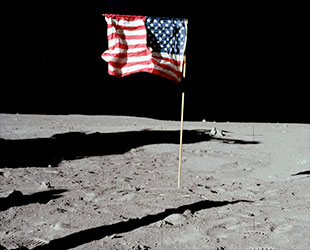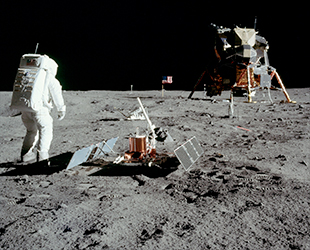July 10, 2013 — As NASA turns away from the moon and towards sending astronauts to Mars (by way of an asteroid or two), two members of Congress have put forth a plan to protect the United States' lunar leftovers.
Reps. Donna Edwards (D-Md) and Eddie Bernice Johnson (D-Texas) introduced on Monday (July 8) the "Apollo Lunar Landing Legacy Act" to create a new National Park on the moon.
According to the bill, which has been referred to the U.S. House of Representatives' Committee on Science, Space, and Technology and the Committee for Natural Resources for further consideration, the proposed national park would encompass the artifacts left on the moon by the six Apollo missions that landed there between 1969 and 1972.
The "Historical Park" would also cover the remains of the Saturn V rocket stages that propelled the missions to the moon and were purposely impacted with the lunar surface, including the S-IVB third stage that launched the Apollo 13 aborted lunar landing mission.
"As commercial enterprises and foreign nations acquire the ability to land on the moon, it is necessary to protect the Apollo lunar landing sites for posterity," Edwards and Johnson wrote in the bill. "Establishing the Historical Park under this act will expand and enhance the protection and preservation of the Apollo lunar landing sites and provide for greater recognition and public understanding of this singular achievement in American history."
To protect and preserve
The bill follows NASA's own efforts to establish guidelines for future lunar visitors, whether human or robotic, when approaching the historic sites. Two years ago, the agency introduced its recommendations for "space-faring entities" on "how to protect and preserve the historic and scientific value of U.S. government lunar artifacts."

The U.S. flag as planted at Tranquility Base by Apollo 11. (NASA) |
The guidelines outlined boundaries or "keep-out of zones" around the Apollo sites, in particular for the first and last landing (Apollo 11 and 17) locations. The Google Lunar X Prize, which has spurred the development of commercial robotic lunar rovers and which, through a "Heritage Prize" encourages visits to the site of man-made objects on the moon, has adopted the NASA guidelines for its competing teams.
The United Nations' Outer Space Treaty of 1967 prohibits governments from claiming the land on the moon (or other celestial bodies), but establishes that spacecraft and other hardware remain the property of their respective countries until purposely relinquished, regardless of where the items may currently reside.
Managing the moon park
The Apollo Lunar Landing Legacy Act assigns jurisdiction over the suggested "Apollo Lunar Landing Sites National Historical Park" to the Secretary of the Interior and NASA Administrator.
Under the legislation's provisions, the space agency would be responsible for ensuring proper monitoring of the Apollo landing sites, as well as managing access to them. NASA would also work with the Smithsonian Institution to verify an "accurate cataloguing of items in the Historical Park."

Tranquility Base, with Apollo 11's lunar module, Passive Seismic Experiment Package, Lunar Ranging Retro Reflector and the U.S. flag. Astronaut Buzz Aldrin is on the left. (NASA) |
The act also calls for an additional action with regards to Tranquility Base, the site where Neil Armstrong and Buzz Aldrin landed on the Apollo 11 mission, within one year of the Historical Park being established.
The Secretary of the Interior, in consultation with NASA's Administrator, will "submit the Apollo 11 lunar landing site to the United Nations Educational, Scientific, and Cultural Organization for designation as a World Heritage Site," the bill reads.
In addition to the Apollo lunar module descent stages, the artifacts left at each of the landing sites include scientific equipment, the astronauts' spent life support backpacks and, with one exception, still-standing American flags. The Apollo 15, 16 and 17 sites are also the parking spots for three lunar roving vehicles, or moon buggies.
